Robert twice became the Mayor of Bristol in 1662
and 1675. When he bought land at Stoke Bishop just outside Bristol on which to
build a house, his success in moving into the county elite was marked by his
term as High Sheriff in 1676. He was Bristol's Member of Parliament in 1678. He received the
honour of knighthood from King Charles the Second on 22nd April 1662, then was
given the baronetcy on the 13th September 1662.
His first wife was Cicily
Hook, daughter of Alderston Humphry Hook of Bristol, and they had two children,
William and Ann. William later inherited the baronetcy from his father and
became the 2nd Baronet of Compton Green.
The second wife of Robert Cann was
Deliverance Cann (1630 to 1656), daughter of John Cann the Preacher and publisher of the1611
King James Bible. They had a son, John (1643 - 1694) and it is this John Cann who
sailed aboard the Griffin in October 1675 arriving in Newcastle Delaware, USA .Deliverance
Cann died in 1656 and was buried in Hull, Yorkshire.
Robert had another
wife, Ann Popley, with whom he had a son, Thomas, born 1662. There could
also have been another marriage with the
sister of Charles Jones.
In 1668, Robert Cann owned land in North
America and was granted a license to transport fifty horses for services on
his plantations in the Barbados. Also, in 1652, the Governor of
Waterford was ordered to deliver to Robert Cann, Robert Yate and Thomas Speed
as many Irish rebel prisoners as they might choose to embark in their ship
bound for the West Indies. Other property included a town house by the
river in Bristol, and a manor house in Compton Greenfield.
It has been recorded in Roger North's
book "Life of Francis North, Baron of Guilford" that
Sir Robert Cann was given a hard time by Judge Jeffries who accused him
of being a "stinking, whining, Presbyterian that could be smelled forty miles off."
A trial was held in London and Sir Robert was acquitted of all charges,
presumably of corruption whilst administering the Bristol council.

This
oval silver tobacco box was made for Sir Robert Cann and is dated 1675.
The
Cann coat of arms is beautifully engraved on it - please click to enlarge the
picture!
Sir Robert Cann died in 1685 and is buried at
All Saint's Church in Compton Greenfield, an area to the north of Bristol.
Whilst many of the genealogical details are
still being researched, there is no doubt that Robert Cann
prospered! He bought land at Stoke Bishop, just outside Bristol and
built himself and his family a new house so that he became landed
gentry. The house was probably finished in 1669, the date which appears
above the porch.
The stone carved porch,
bearing the date 1669 (Click to enlarge)
The Cann's new house was built at a time when
it was just becoming usual for country houses to be designed in the Classical
style. A detailed description of the architecture appears in a book "The
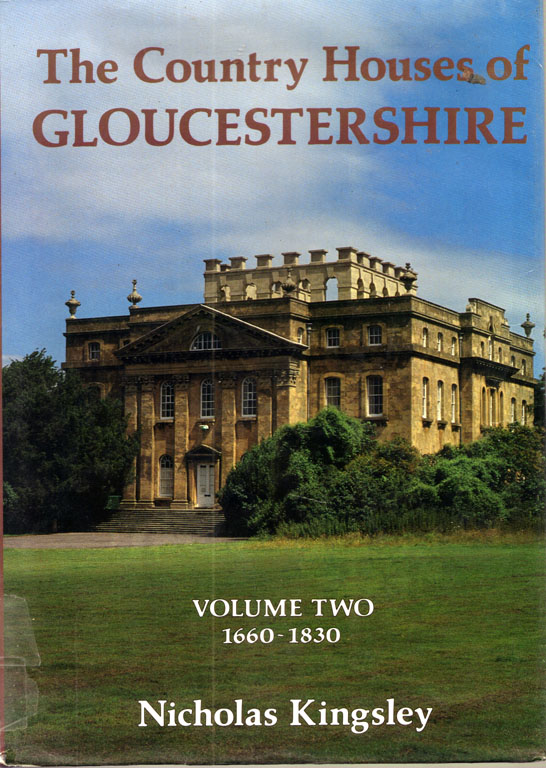 Country Houses of Gloucestershire" Volume 2 (1660 - 1830) by N. Kingsley
and published by Phillimore, in 1992, easily obtainable in UK libraries.
Country Houses of Gloucestershire" Volume 2 (1660 - 1830) by N. Kingsley
and published by Phillimore, in 1992, easily obtainable in UK libraries.
Subsequent owners have carried out
alterations in a variety of styles, adding windows, removing cupolas and
adding a conservatory.
The great-grandson of the builder of Stoke
Bishop, another Sir Robert Cann ( or was this William?), died without issue in
1765, and the family estates descended to his nephew, Robert Cann Jeffries. He
carried out extensive restorations to the house, but after his untimely death
in 1773, his sister
Catherine found herself suddenly to be a wealthy, eligible spinster and was married the following year to Henry Lippincott. Henry carried on
making alterations to the offices and gardens, and also diverted a turnpike
road to create a lawn in front of the house. The Cann-Lippincot
family retained the house well into the 19th century, but it was sold in about
1800 to Sir R. B. Johnstone and so passed out of the Cann family.
|
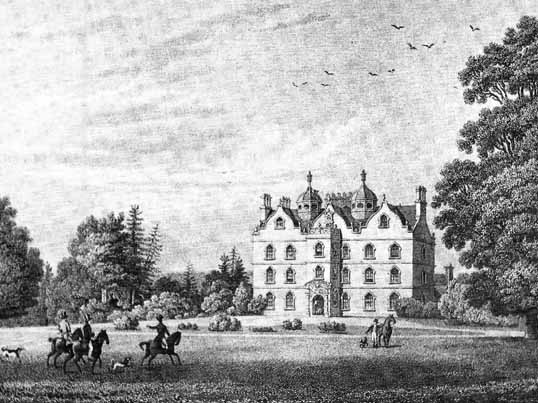
|
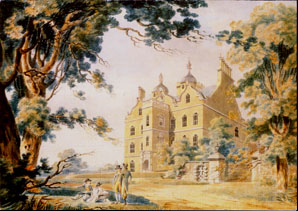
|
|
Stoke House by
Brewer |
Painting of Stoke House in
1791, by John Turner |
Other references to this house and family may be found from
the following sources;
1) Bristol Evening Post - Thursday, 3rd July 1954
(Photos of Stoke House)
2) "A Pictorial History of Stoke Bishop and
Sneyd Park" compiled by Penny Jetzer, Diana Bourne, Elizabeth Floyd
& Monica Carp of the Stoke Bishop and Sneyd Park Local History Group
(first published in 1998)
3) "The Lives of the North's" by Dudley North
4) "The Life of Francis North, Baron of Guilford"
by Roger North
5) The Stoke Bishop and Sneyd Park History Group have produced
a video, available as American standard NTSC version and English.
 'Country
Air, Channel Breezes', is 60 minutes long and is presented by David
Garmston, a local BBC broadcaster. The video is a mix of archive photographs,
contemporary interviews and reconstructions. It traces the history of the
Bristol suburb from pre-historic times to the present day. A short drama scene
about the sale of Stoke House estate lands in 1869 for house building was
filmed at Stoke House. See the picture of actors outside the famous
porch and click to enlarge!
'Country
Air, Channel Breezes', is 60 minutes long and is presented by David
Garmston, a local BBC broadcaster. The video is a mix of archive photographs,
contemporary interviews and reconstructions. It traces the history of the
Bristol suburb from pre-historic times to the present day. A short drama scene
about the sale of Stoke House estate lands in 1869 for house building was
filmed at Stoke House. See the picture of actors outside the famous
porch and click to enlarge!
The video may still be obtainable from
The Stoke Bishop and Sneyd Park History Group
23, Church Road
Stoke Bishop
Bristol
BS9 1QP
UK
Stoke House is presently occupied as a Theological
College, known as Trinity College, and can be seen on http://www.trinity-bris.ac.uk
The Cann Coat of Arms
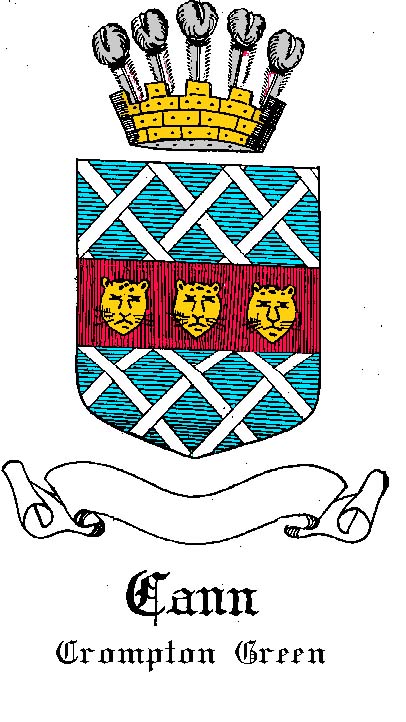 This drawing appears in "The Paternal Record of Ida May Cann Goode
From Reverend John Cann of England" a book published in 1927.
Colours have been added for better effect.
This drawing appears in "The Paternal Record of Ida May Cann Goode
From Reverend John Cann of England" a book published in 1927.
Colours have been added for better effect.
The Coat of Arms is listed in Fairbairn's Book of Crests
of Great Britain & Ireland, published in London, 1915, under CANN
(Extinct) of Compton Greenfield, Gloucestershire. It is also listed in
Burke's General Armory of England, Scotland, Ireland and Wales.
Heraldic artists developed their
own unique language to describe Coats of Arms. In their words the Arms
(shield) is described as follows;
"Az.fretty ar. on a fesse gu. three
leopards' faces or"
When translated, the arms description is
"Blue with silver trelliswork on middle third red, three gold leopards'
faces.
Above the shield and helmet is the crest
which is described as
"Out of a mural coronet or, a plume of
five ostrich feathers ar"
When translated, this becomes, "Out of a
gold crown, a plume of five silver ostrich feathers".
The coat of arms was created on the 13th September
1662. Two years later, there was an addition to the arms from Sir Edward
Walker, Garter King of Arms "on a Fesse three leopards faces of
gold"
If we look closely at my painting below, there is a hand on the shield.
This appears in the carvings on the chair, and at Stoke
Bishop House, but not on the illustration from Ida May Cann
Goode's book of William Cann's arms. Is this perhaps the
addition from Sir Edward Walker?
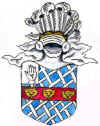
Click to enlarge
Heraldic Terms used in the Cann Coat of Arms
A Fesse is formed by two horizontal lines. It
is emblematic
of the military girdle worn round the body over the
armour
Fretty is interlaced fillets crossing the field or
charge lozengways.
Lozengy is when the field is divided by diagonal
lines transversely
into equal parts or lozenges.
Ar means white or silver . Az means
blue. Gu means red. Or means
yellow or gold. .
The Cann Chair
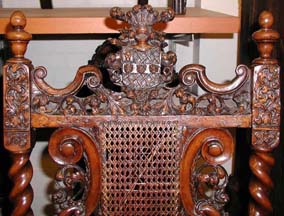
This beautiful carved armchair is presently in store at the Burrell
Collection, Glasgow, Scotland having survived over 300
years. It is made of walnut and is dated 1699 featuring the
Cann coat of arms and the initials "WC" .
A former student at
Glasgow University, Erin Gobel (now Erin French M.Phil in Decorative
Arts) made this chair one of the subjects in her
research assignment in December 2001, for the Phillips (now Bonhams) Decorative Arts
Programme. The following text and pictures have been extracted from her
essay.
Description of the chair
Carved, pierced cascading scrolls and floral motifs in high relief
surround the caned back splat. The outward-turning arms are supported by
carved, pierced arm supports terminating in large ball feet that are
accented with floral carving.
The carved front stretcher features
the cypher monogram "WC" at its centre, surrounded by further
scrolling elements.
Joined construction is employed throughout and the
chair has undergone extensive strengthening vertically and horizontally at the
back.
Height 55 ½ inches (141 cm) Width 29 inches (74
cm) Depth 24 inches (61 cm)
If we look at the barley twisting columns of the entrance
porch of Stoke House, we can see a reflection of them in the chair. Emphasis is placed
on verticality, which exudes power, dominance and high status. When
compared to the entry, the chair takes on a new architectural sense that links
it even more firmly to this house.
Further notes
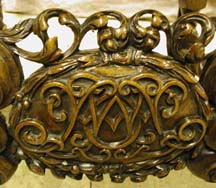 It
is almost certain that the WC initials belong to William Cann, son of Sir
Robert Cann as it was William who inherited the baronetcy upon his father's
death. (Reference: Cann, William Ferris and James T Eliason, "The Story of John Cann, 1645 - 1694 of Delaware and His
Descendants"
It
is almost certain that the WC initials belong to William Cann, son of Sir
Robert Cann as it was William who inherited the baronetcy upon his father's
death. (Reference: Cann, William Ferris and James T Eliason, "The Story of John Cann, 1645 - 1694 of Delaware and His
Descendants"
Although it may be hard to see a WC we have confirmation
of it from an entry in the Dictionary of English Furniture, 1953,
volume I., page 241, fig. 57 which states that the cypher W.C. is on
the front stretcher.
Being an upper class family, the Canns would have been
accustomed to well made furniture. This chair would have had a cushion upon
which William Cann sat, that completed the stately appearance of the
chair. Its position in the house would probably have been on the first
floor, at the top of the main staircase in a grand dining room, decorated in
the Baroque style. Here we can imagine the Cann family entertaining
guests and having smaller intimate dinners. During these meals, Sir
William Cann, grandson of the first Cann mayor of Bristol, occupied his chair
which would have been more elaborate than any of the other dining
chairs.

